eOrganic authors:
Joyce E. Parker, USDA National Institute of Food and Agriculture, Division of Community and Education (USDA NIFA DOCE)
William E. Snyder, Washington State University, Department of Entomology
This article examines the general biology and management of flea beetles attacking cruciferous and solanaceous crops within organic farming systems.
Introduction
Flea beetles are a diverse group of leaf beetles (Chrysomelidae). Some flea beetles are important economic pests, while others are beneficial weed biological control agents. More information on flea beetles used for weed biological control can be found in this North Dakota State University fact sheet. In North America, flea beetles most often become pests when attacking plants in the families Brassicaceae, also known as crucifers and cole crops (e.g. broccoli, kale, cabbage, collards), and Solanaceae (e.g. potatoes, tomatoes, eggplant, peppers). Flea beetles are highly mobile, making control difficult.
Flea Beetle Identification, Biology, and Distribution
Flea beetle adults (Fig. 1) are small (1/15 to 1/6 inch long) with enlarged hind legs that allow them to jump several inches at a time. Flea beetles are also strong fliers, moving into crop fields from neighboring fields and weedy borders.

Figure 1. Crucifer flea beetle, Phyllotreta cruciferae, on broccoli head. Photo credit: Joyce Parker, AAAS S&T USEPA.
The major flea beetle pests in organic brassicas and solanaceous crops in North America are listed in Tables 1 and 2, and images of adults are shown in Figures 2 and 3. Adults of some flea beetle species can be difficult to tell apart. For example, both the tuber flea beetle and western potato flea beetle may look metallic brown, black, or bronze (Berry, 1998) depending on light intensity (Figs. 3e and 3f). The tuber flea beetle appears dull black in bright light, whereas the western potato flea beetle tends to have a more bronze appearance (Northwest Potato Research Consortium). The tuber flea beetle and western potato flea beetle are so similar in appearance that only a microscopic inspection of reproductive parts can distinguish the two species. Generally, although diet preferences may overlap, most flea beetle species favor certain plant families (Cranshaw, 2006).
Overwintering flea beetle adults emerge in mid- to late spring, become more active when the days get warmer, and move into fields as their preferred host plants become available (Antonelli and Davidson, 2001). The adults actively search for emerging host plants using visual as well as chemical/olfactory (smell) cues (Cranshaw, 2006). Adult flea beetles deposit their eggs in the soil at the base of a host plant where larvae hatch from eggs, feed on below-ground portions of the plant, and then pupate in the soil. Adults emerge to feed on above-ground foliage, then overwinter under protective plant debris (e.g., leaf litter), in grassy and woody field borders, and in ditch banks. Depending on location, one to multiple generations of flea beetles are completed annually. Generally, warmer temperatures allow for more flea beetle generations to be completed.
Table 1. The most common Brassica feeding flea beetles found in North America.
| Brassica Feeders | Scientific Name | Reported to Damage | Distribution |
| Crucifer flea beetle | Phyllotreta cruciferae | Brassicaceae family | Northern US |
| Horseradish flea beetle | Phyllotreta armoraciae | Horseradish, occasionally damages cabbage, radish and turnip | Northern US and usually east of the Rockies |
| Striped flea beetle | Phyllotreta striolata | Brassicaceae family | Eastern and Pacific regions of the US |
| Western black flea beetle | Phyllotreta pusilla | Brassicaceae family, occasionally damages beet, lettuce and potato | Western US |
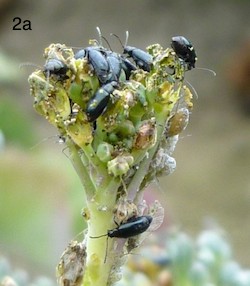

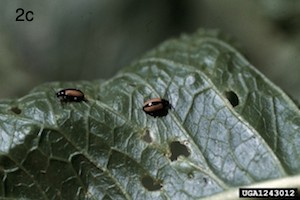
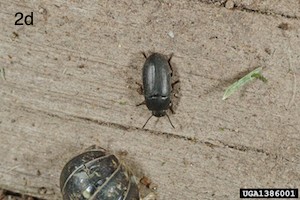
Figure 2. Brassica feeding flea beetles. (a) crucifer flea beetle (b) striped flea beetle (c) horseradish flea beetle (d) western black flea beetle. Photo credits: (a) Joyce Parker, AAAS S&T Policy Fellow USEPA.; (b) Whitney Cranshaw, Colorado State University, Bugwood.org; (c) Merle Shepard, Gerald, R. Carner and P.A.C. Ooi, Bugwood.org; (d) Joseph Berger, Bugwood.org.
Table 2. The most common solanaceous feeding flea beetles found in North America.
| Solanaceous Feeders | Scientific Name | Reported to Damage | Distribution |
| Eggplant flea beetle | Epitrix fuscula | Eggplant and potato | Eastern US |
| Palestriped flea beetle* | Systena blanda | Very wide host range | Primarily a pest in warmer areas of the US |
| Potato flea beetle | Epitrix cucumeris | Potato, tomato and other members of Solanaceae family | East of the Rockies |
| Tobacco flea beetle | Epitrix hirtipennis | Eggplant, pepper, potato, tomato and other members of Solanaceae family | Warmer areas of the US |
| Tuber flea beetle | Epitrix tuberis | Potato, especially potato tubers | Pacific Northwest |
| Western potato flea beetle | Epitrix subcrinita | Potato and other members of Solanaceae family | Western US |
* Most flea beetles feed on a narrow range of host plants. However, the palestriped flea beetle has a very wide host range including plants in the Solanaceae family as well as corn, cotton, grape, melon, oat, pea, peanut, pear, pumpkin, and strawberry.
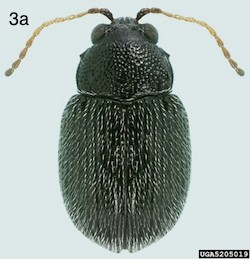
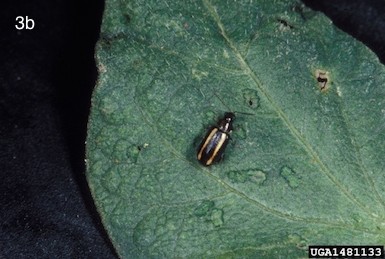




Figure 3. Solanaceous flea beetles. (a) eggplant flea beetle (b) palestriped flea beetle (c) potato flea beetle (d) tobacco flea beetle (e) tuber flea beetle (f) western potato flea beetle. Photo credits: (a) Natasha Wright, Florida Department of Agriculture, Bugwood.org; (b) Frank Peairs, Colorado State University, Bugwood.org; (c and d) Whitney Cranshaw, Colorado State University, Bugwood.org; (e) G. H. Spitler, Washington State University; (f) Ken Gray, courtesy of Oregon State University.
Damage Caused by Flea Beetles in Brassica and Solanaceous Crops
Both larval and adult stages have chewing mouthparts, which they use effectively below ground (larvae) and above ground (adults). Below- and above-ground feeding damage can kill seedlings and small transplants. In addition, scars on potato tubers from below-ground feeding can reduce marketability, while scars on foliage from above-ground feeding may render produce unmarketable. Flea beetle feeding damage can sometimes lead to total crop loss. However, minor damage to foliage, particularly to non-marketable parts of the plant, can be tolerated without a loss in yield. For example, plants such as eggplant recover well from flea beetle damage.
Below-ground
Flea beetle larvae feed on plant roots and root hairs. However, this feeding generally does not cause significant economic losses (Cranshaw, 2006) unless feeding is done by the tuber flea beetle larvae which feed on potato tubers. The western potato flea beetle larvae feed primarily on the roots of potatoes; however they have also been known to feed on potato tubers.
Tuber flea beetle larval damage to potatoes can be significant. Larvae create winding shallow grooves on the surface of potato tubers that can lead to scar formation (Fig. 4a). Larvae can also burrow into the tubers, in which case there will be a small entry hole that is often filled with frass (dark-colored excrement) that can stain the tuber. These holes can also cause indirect damage by serving as entry points for microorganisms that reduce storage potential or cause potatoes to rot (Antonelli and Davidson, 2001). Damage to plant roots and root hairs may cause reductions in the size and health of plants; however, it usually does not result in significant economic loss.
Above-ground
Adult flea beetles feed on above-ground portions of plants, including stems, leaves, and flowers. Chewing damage on leaves results in a characteristic pitting or shot-holing. When leaves of host plants are waxy and thick (e.g., broccoli leaves), feeding damage appears as pitting (Fig. 4b). Damage to the thinner leaves (e.g., mustard and potato plants) (Figs. 4c and 4d, respectively) looks like shot-holes ranging in size from 1/16 to 1/8 inch in diameter. Severe damage to above-ground plant parts can kill seedlings and young transplants, and in older plants can lead to crop stress, reduced growth, stunting, and eventual death (Berry, 1998).
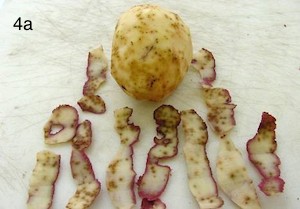

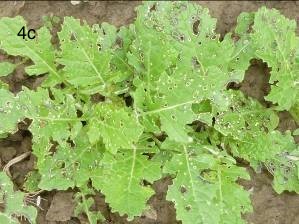
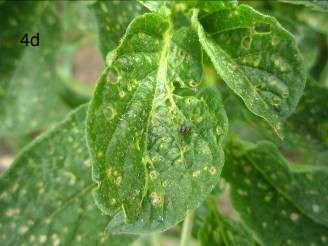
Figure 4. Flea beetle damage on Brassica and Solanaceous crops. (a) tuber flea beetle larvae feeding damage on potato tuber (b) pitting damage on broccoli leaf by adult crucifer flea beetle (c and d) shot-hole feeding damage by adult crucifer flea beetle on mustard leaf. Photo credit: (a and d) G. H. Spitler, Washington State University; (b and c) Joyce Parker, AAAS S&T Policy Fellow USEPA.
Organic Management Methods
Understanding the biology and life cycle of flea beetles will help to determine the most effective suppressive strategies at the optimum time to manage these difficult and destructive pests. For example, crop rotation is usually not a viable management strategy because flea beetles are extremely mobile and can readily migrate from field to field. However, potato tuber flea beetle densities tend to be greater in fields previously planted with potatoes, so you should avoid planting a highly susceptible crop after potatoes. The following are organically approved and effective cultural, mechanical, biological, and organic chemical strategies to reduce flea beetle populations.
Cultural
Planting schedule. Planting schedules can sometimes be adjusted to minimize damage, but this depends on the species and location. For example, some species of flea beetle larvae emerge in mid- to late spring and adults emerge in mid-summer through fall: by planting earlier or later, you can avoid flea beetle larval feeding, adult emergence, and peak adult feeding activity. For example, to minimize the accumulation of damage from tuber flea beetle larvae, plant and harvest potatoes earlier in the season as tuber damage from tuber flea beetles will increase as the flea beetle population grows (Ambrosino, 2008). An alternative method includes planting potatoes later in the season when the temperatures are warmer. This can help plants outgrow the injury caused by flea beetle feeding (Burkness and Hahn, 2007). In brassica crops grown in northern climates, one option is to plant later in the season, which will reduce areas where overwintered flea beetles can feed and reproduce.
Trap crops. A trap crop is a stand of plants grown to attract pest insects away from the cash crop, and/or to intercept the pest as it migrates into a cropping field (Hokkanen, 1991; Shelton and Badenes-Perez, 2006) (Fig. 5). Trap crops should always be planted or transplanted before the cash crop in order to provide a food source to the pest insects. Once flea beetles start to feed on the trap crop, you can kill the pests with a botanically-based insecticide or by tilling the infested trap crop into the ground. To be effective, the trap crop must be more appealing to the pest than the cash crop. For example, Chinese southern giant mustard (Brassica juncea var. crispifolia) is an example of a trap crop that has been used effectively in the United States to protect crucifer crops from flea beetle damage (Grubinger, 2005). Trap crop experiments conducted in Connecticut showed eggplant flea beetles preferred the elongated Italian or Japanese eggplant variety Vittoria to standard eggplant and tomato varieties (Grubinger, 2004). Because trap crops may vary in their attractiveness over time, it may be important to make multiple plantings of the trap crop.
Trap crops can also be deployed as monocultures (one trap crop species) or as mixes in polycultures (many trap crop species). Researchers at Washington State University (WSU) explored the use of simple (monocultures) and diverse (polycultures) trap crops to control the crucifer flea beetle in broccoli and found that certain species were more effective than others. Table 3 lists the trap crop species used and its level of attractiveness to the crucifer flea beetle. Further studies concluded that a diverse trap crop containing Pacific Gold mustard, (Brassica juncea), Dwarf Essex rape (B. napus), and pak choi (B. campestris L. var. chinensis) protected broccoli from the crucifer flea beetle more successfully than these species planted alone or in polycultures of two species (Parker, 2012). Diverse trap crops combine plants that have different phenologies (life cycles that can be influenced by the environment, weather conditions, and nutrition), chemical profiles, and physical structures that make them more attractive to flea beetles. For example, in the WSU experiments the authors observed rape to mature later in the season than mustard and pak choi, possibly providing the crucifer flea beetle with a continuously attractive trap crop blend throughout the season. The mixture of chemical profiles the diverse trap crop contained may have also enhanced its effectiveness. The chemical component crucifer flea beetles are attracted to in Brassica plants are glucosinolates and the chemical profile varies between different brassica species. For example, the primary glucosinolate in Pacific Gold mustard (B. juncea) is also known as allyl glucosinolate or sinigrin, while rape has four main glucosinolates that occur in various concentrations (Davis, 1988).
Figure 5. A trap crop composed of mustard is flanked on both sides by a broccoli-cash crop. Photo credit: Joyce Parker, AAAS S&T Policy Fellow EPA.
It is important to note, however, that trap crops may not provide complete protection, especially during heavy pest infestations when the pest will spill over to the cash crop. Using trap crops in addition to other cultural control practices is beneficial. Pest behavior and distribution in the field can also impact the success of trap crops. For example, low densities of crucifer flea beetles have been shown to concentrate near the edges of broccoli crops, but will move into the centers of these fields as densities increase (Parker, 2012). The shape of a trap crop may influence such reactions. For example, a perimeter trap crop (Fig. 6a) vs. one planted only along one side of a cash crop (Fig. 6b) creates a barrier around the entire border of a cash crop, and thus may be more effective if flea beetles concentrate around field edges. For trap cropping to be successful, the trap crop should be 10% of the crop area used (Hokkanen, 1991) or even more (Shelton and Badenes-Perez, 2006). Since the trap crop is consumed and damaged by the pest, it is usually unmarketable.
Table 3. Trap crop species and its level of attractiveness to the crucifer flea beetle.
| Common Name | Scientific Name | Trap Crop Attractiveness |
| Pacific Gold Mustard | Brassica juncea | High |
| Pac Choi | Brassica campestris L. var. chinensis | High |
| Dwarf Essex Rape | Brassica napus | Moderate |
| Green Glaze Collard | Brassica oleracea var. acephala | Moderate |
| Yellow Rocket | Barbarea vulgaris | Low |
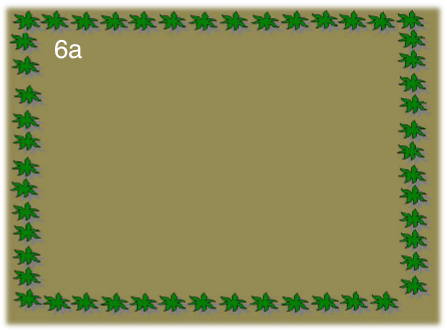

Figure 6. Perimeter trap crop arrangements. (a) a perimeter trap crop is planted around a field border (b) a strip trap crop is planted along one side of a field.
Companion plants. Companion plants can confuse, repel, or block insect pests from finding host plants. Bunching green onions, dill, and marigolds are a few examples of companion crops that have been used for flea beetle management. By intercropping or planting companion plants next to host plants, you will create a more diverse planting that makes the host plants less apparent to the pest. However, field trials at Washington State University found no benefit of companion plants of the species tested (spring onion, Yukon Gold potato, dill and marigold) for protecting broccoli from crucifer flea beetle damage (Parker, 2012).
Mulches. Living mulches are crops that can be interplanted with or undersown within a cash crop to interfere with the flea beetle’s ability to locate host plants. Just as with companion plants, living mulches could obscure host plants from flea beetles (McKinlay, 1992). Living mulches also provide habitat for ground-dwelling beneficial insects such as predatory ground beetles which might feed on the larval and adult stages of flea beetles. However, living mulches may also harbor various pests of the cash crop.
Although little research has been done to identify specific living mulches and ground covers that are effective in flea beetle suppression, in general, living mulches can consist of legumes such as clover and vetch. It is important to note that living mulches can compete with cash crops for nutrients, space, and water, sometimes reducing yield, and thus it may be best to plant living mulches in alleyways between crop beds (Hooks and Johnson, 2004).
Non-living mulches can be used to interfere with or inhibit flea beetle oviposition (i.e., egg laying). Researchers at Oregon State University saw a moderate improvement in flea beetle control when barley straw mulch or municipal yard waste large leaf mulch was applied in small-scale organic potato fields in plots of at least 150 square feet (personal communication with Mario Ambrosino).
Sanitation. Sanitation practices such as mowing and tilling weeds (especially early in the season), and removing plant debris within cash crops, can reduce flea beetle populations by minimizing food sources and overwintering habitat. Particularly troublesome weeds are volunteer host plants such as weedy mustards that might be used by crucifer flea beetles, or weedy nightshades that might be used by potato flea beetles.
Mechanical and Physical
Floating row covers. Floating row covers are physical barriers placed over cash crops to exclude flea beetles. It is essential that the floating row cover be installed over the crop before flea beetles are in the area, and secured well on all sides. If flea beetles get under the row cover, they can feed without interruption from natural enemies or adverse environmental factors. Row covers are an effective way to prevent flea beetle damage in fields without overwintering populations. Although row covers can be expensive and unwieldy if used to cover large areas, they can be reused for many years if carefully handled (Chasson, 2010). Clean row covers may last longer since soil particles can abrade and tear these covers (Pleasant, 2008). Dirty row covers can be hosed down with water, but it is important to let them dry completely before storing (Pleasant, 2008). More information on row cover materials and installation can be found in the Washington State University fact sheet How to Install a Floating Row Cover.
Sticky traps. Yellow sticky traps and sticky tape will physically capture flea beetles, but they also attract some beneficial insects. Place sticky traps around the host plants and replace when they are full or no longer sticky (e.g., blowing soil has covered them). Sticky traps are most effective as part of scouting programs to monitor and detect flea beetle populations.
Biological
Parasites and predators. A native parasitoid wasp, Microctonus vittatae, is found throughout North America and can kill adult flea beetles, although the rate of parasitization is low (Knodel and Olson, 2002). Generalist predators such as lacewing larvae (Chrysoperla spp.) (Fig. 7a), big eyed bugs (Geocoris spp.) (Fig. 7b), and damsel bugs (Nabis spp.) (Fig. 7c) have also been known to feed on adult stages of flea beetles (Knodel and Olson, 2002). Flowering plants such as anise, dill, chamomile, marigold, or clover can be grown around the host plants to enhance floral resources and encourage the native parasitic wasp and other generalist predators (Gredler, 2001). For more information on strategies to conserve predators, see the eOrganic article, Farmscaping: Making Use of Nature’s Pest Management Services.
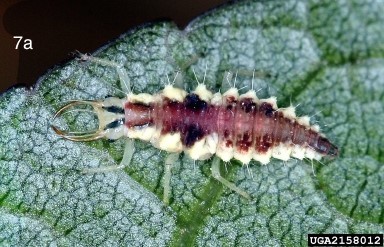
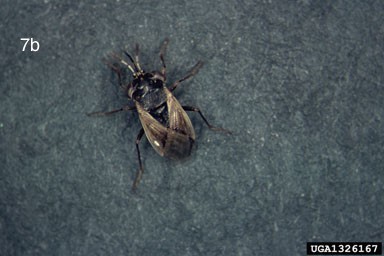
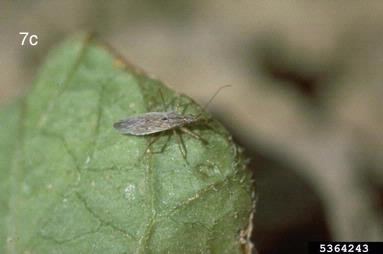
Figure 7. Generalist predators that have been known to feed on flea beetle adults. (a) lacewing larvae (Chrysoperla spp.) (b) big eyed bugs (Geocoris spp.) (c) damsel bugs (Nabis spp.). Photo credits: (a) Frank Peairs, Colorado State University, bugwood.org; (b and c) Whitney Cranshaw, Colorado State University, Bugwood.org.
Entomopathogenic nematodes. Entomopathogenic nematodes are soil-dwelling parasitic, unsegmented worms that kill insects. Many insects that have a life cycle in the soil, including flea beetles, are susceptible to biological control organisms. Entomopathogenic nematodes in the families Steinernematidae and Heterorhabditidae can attack the larval stage of flea beetles, thereby reducing the emerging population. Furthermore, the nematode species Steinernema carpocapsae has been demonstrated to decrease damage caused by flea beetle larvae in potatoes (Ambrosino, 2008). Information on entomopathogenic nematodes are presented in the article, Insect-Parasitic Nematodes for the Management of Soil-Dwelling Insect Pests.
Biological Pesticides
Fungal pathogens. Beauvaria bassiana is a fungus commonly found in many soils, and it causes a disease in insects known as white muscadine (Caldwell et al., 2013) that has been shown to reduce flea beetle populations. When insects come into contact with B. bassiana fungal spores, either by sprayed droplets or exposure to a treated surface, the spores attach to the insect, germinate, and penetrate the insect's body. The fungus releases toxins that liquefy the insides of the insect, creating a food source for the fungus and subsequently killing the insect (Caldwell et al., 2013). The B. bassiana strains GHA and ATCC 74040 are effective at controlling flea beetles, and some formulations are organically approved and can be purchased commercially. It is most effective to apply B. bassiana in the evenings because sunlight can kill these spores.
Other Biological and Botanical Pesticides
There are several commercial insecticides labeled to control flea beetles and allowed for use in certified organic production. More information on research-based Organic Materials Review Institute (OMRI) approved pesticides to manage flea beetles on vegetable crops can be found in the Cornell University article Efficacy Trials of OMRI Approved Materials on Vegetable Crops. However, always check with your certifier before purchasing or using a new product to ensure its use in your organic farming system. For more information see the article, Can I Use This Input On My Organic Farm. Also, keep in mind that even natural insecticides can have broad-spectrum actions that kill beneficial insects in addition to the targeted pest. Always consult the label for specific usage before applying a pesticide.
Varietal Resistance
Flea beetles can also be managed using resistant plant varieties. This, however, is most successful under light flea beetle infestations. For example, leaves that are smooth and glossy are more preferred than rough, hairy, waxy or glandular (sticky) leaves (Hoffmann et al., 1999; Ambrosino, 2008; Bohinc et al., 2014). Similarly, non-glandular trichomes (hairs) on leaves can act as physical barriers complicating flea beetle feeding on canola (Soroka et al., 2011).
Region-specific Information on Flea Beetle Biology
- California
- Colorado
- Massachusetts (Flea beetles on Cruciferous crops)
- Massachusetts (Flea beetles on Solanaceous crops)
- Minnesota
- North Carolina
- North Dakota
- Texas
NOTE: Many of the controls described on the above links are NOT APPROVED FOR USE IN CERTIFIED ORGANIC FARMING, although the details of local flea beetle biology are applicable to organic farming systems.
References and Citations
- Ambrosino, M. 2008. Flea beetle pest management for organic potatoes [Online]. Oregon State University Extension Service EM 8947-E. Available at: http://ir.library.oregonstate.edu/xmlui/bitstream/handle/1957/20499/em8947-e.pdf (verified 6 Apr 2023).
- Antonelli, A. L., and R. M. Davidson. 2001. Potato flea beetles: Biology and control. Washington State University Extension Bulletin 1198E. Available at: http://whatcom.wsu.edu/ag/documents/seedpotatoes/eb1198e.pdf (verified 6 Apr 2023).
- Berry, R. E., and P. Mooney. 1998. Insects and mites of economic importance in the Northwest. 2nd ed. Oregon State University, Corvallis, OR.
- Bohinc, D. M., and S. Trdan. 2014. Leaf epicuticular wax as a factor of antixenotic resistance of cabbage to cabbage flea beetles and cabbage stink bugs attack. Acta Agriculturae Scandinavica, Section B—Soil and Plant Science 64: 493-500. (Available online at: doi:10.1080/09064710.2014.926978) (verified 6 Apr 2023)
- Burkness, S., and J. Hahn. 2007. Flea beetles in home gardens [Online]. University of Minnesota Extension Publication M1210. Available at: http://www.extension.umn.edu/Garden/insects/find/flea-beetles/ (verified 6 Apr 2023).
- Caldwell, B., E. Sideman, A. Seaman, A. Shelton, and C. Smart. 2013. Material fact sheet: Beauveria bassiana (p. 113-116). In: Resource guide for organic insect and disease management. Cornell University/NYSAES, Geneva, NY. Available online at: http://web.pppmb.cals.cornell.edu/resourceguide/pdf/resource-guide-for-organic-insect-and-disease-management.pdf (verified 6 Apr 2023).
- Chasson, F. 2010. The use of floating row covers [online]. Colorado Master Gardener, Colorado State University Cooperative Extension, Denver County. Available at: http://www.colostate.edu/Dept/CoopExt/4DMG/VegFruit/rowcover.htm (verified 6 Apr 2023).
- Cranshaw, W. 2006. Flea beetles. Colorado State University Extension Fact Sheet 5.592 [Online]. Colorado State University, Ft. Collins, CO. Available at: http://www.ext.colostate.edu/pubs/insect/05592.pdf (verified 6 Apr 2023).
- Davis, J. B. 1988. Winter rapeseed (Brassica napus L.) with differential levels of glucosinolates evaluated as a green manure crop to suppress Aphanomces root rot of peas (Pisum sativum L.). MS thesis. University of Idaho, Moscow, ID.
- Gredler, G. 2001. Encouraging beneficial insects in your garden. [Online]. Pacific Northwest Extension Publication PNW0550. Oregon State University, Corvallis, OR. Available at: https://catalog.extension.oregonstate.edu/pnw550 (verified 6 Apr 2023).
- Grubinger, V. 2004. Perimeter trap cropping: A novel approach to insect pest control. [Online]. University of Vermont Extension, Brattleboro, VT. Available at: http://www.uvm.edu/vtveganberry/factsheets/perimeterTC.html (verified 6 Apr 2023).
- Grubinger, V. 2005. Flea beetles management. [Online]. University of Vermont Extension, Brattleboro, VT. Available at: http://www.uvm.edu/vtvegandberry/factsheets/fleabeetle.html (verified 6 Apr 2023).
- Hokkanen, H. 1991. Trap cropping in pest management. Annual Review of Entomology 36: 119-138. Available for purchase online at: http://www.annualreviews.org/doi/abs/10.1146/annurev.en.36.010191.001003 (verified 6 Apr 2023).
- Hoffmann, M., R. Hoebeke, and H. Dillard. 1999. Flea beetle pests of vegetables. Vegetable crop fact sheet. Cornell University Integrated Pest Management. Available online at: https://ecommons.cornell.edu/bitstream/handle/1813/43272/flea-beetles-veg-FS-NYSIPM.pdf?sequence=1) (verified 6 Apr 2023)
- Hooks, C., and M. Johnson. 2004. Using undersown clovers as living mulches: Effects on yields, Lepidopterous pest infestations, and spider densities in a Hawaiian broccoli agroecosystem. International Journal of Pest Management 50(2): 115-120. Available for purchase online at: http://www.tandfonline.com/doi/abs/10.1080/09670870410001663462#.VKnBomTF9z8 (verified 6 Apr 2023).
- Knodel, J., and D. Olson. 2002. Crucifer Flea Beetle biology and integrated pest management in Canola. [Online]. North Dakota State University Extension Publication E-1234. Available at: https://www.ag.ndsu.edu/extensionentomology/field-crops-insect-pests/Documents/canola/crucifer-flea-beetle-biology-and-integrated-pest-management-in-canola/view (verified 6 Apr 2023).
- Lym, R. G. 2013. Leafy spurge control using flea beetles (Apthona spp.). North Dakota State University Extension Publication W1183. Available at: http://www.ag.ndsu.edu/pubs/plantscie/weeds/w1183.pdf (verified 6 Apr 2023).
- McKinlay, R. (ed.) 1992. Vegetable crop pests. CRC Press, Boston, MA.
- Northwest Potato Research Consortium. Flea beetle–Epitrix tuberis. (Available online at: https://www.nwpotatoresearch.com/item/flea-beetle-epitrix-tuberis) (verified 6 Apr 2023)
- Parker, J. E. 2012. Diversity by design: Exploring trap crops and companion plants to control Phyllotreta cruciferae, the crucifer flea beetle, in broccoli. Doctoral Dissertation. Washington State University, Pullman, WA.
- Pleasant, B. 2008. Row covers: The no-spray way to protect plants. Mother Earth News. (Available online at: http://www.motherearthnews.com/organic-gardening/row-covers-zmaz08fmzmcc.aspx#axzz3H0AWu7bL) (verified 6 Apr 2023).
- Shelton, A. M., and F. R. Badenes-Perez. 2006. Concept and applications of trap cropping in pest management. Annual Review of Entomology 51: 285-308. Available for purchase online at: http://www.annualreviews.org/doi/abs/10.1146/annurev.ento.51.110104.150959 (verified 6 Apr 2023).
- Soroka, J. J., J. M. Holowachuk, M. Y. Gruber, and L. F. Grenkow. 2011. Feeding by flea beetles (Coleoptera: Chrysomelidae; Phyllotreta spp.) is decreased on canola (Brassica napus) seedlings with increased trichome density. Journal of Economic Entomology 104: 125-136. Available for purchase online at: http://www.crossref.org/iPage?doi=10.1603%2FEC10151 (verified 6 Apr 2023).
NOTES: The views and opinions expressed in this article are those of the authors and do not necessarily reflect those of the United States Department of Agriculture.
This work was completed while the author was employed as an AAAS Science & Technology Policy Fellow at the USEPA.
.



